Current battery technology places the same range restrictions on electric commercial trucks as on electric cars.
So while electric trucks may be suitable for local delivery service and other short-range operations, they can't cut it in long-haul trucking at the moment.
However, Swiss rail-infrastructure company Furrer+Frey has a fairly simple and low-tech solution: tractor swapping.
DON'T MISS: Lighter Volvo aero truck concept is 30 percent more fuel-efficient
Furrer+Frey—which provides equipment for rail electrification—recently acquired Opbrid, a developer of overhead-pantograph charging systems for trucks and buses.
The combined companies (as Furrer+Frey Opbrid) are now investigating ways to electrify long-haul trucks.
Tractor swapping may be one of the most straightforward ways to accomplish that, argued Opbrid founder and current Furrer+Frey executive Roger Bedell in a recent presentation covered by Green Car Congress (via Charged EVs).

Volvo Concept Truck
In a way, it's similar to the current procedure of the Formula E electric-car racing series, where drivers swap cars mid-race.
Certain commercially-available hardware could facilitate this process, Bedell noted in his presentation.
MORE: Recovered Energy And Ultracapacitors Could Cut Big-Rig Fuel Use (Oct 2015)
One is the Jost KKS automated coupling system, which can couple and uncouple tractors and trailers with minimal driver involvement.
This would theoretically speed up the swapping process.
To ensure tractors get charged in preparation for swaps, Bedell volunteered his company's own Trukbaar system.

Furrer+Frey Opbrid Trukbaar charging system
Even with the necessary charging stations, Bedell claims tractor swapping would be the least complex option for electric long-haul trucks in terms of infrastructure.
However, he also noted that there are some potential drawbacks.
Fleets of tractors and trailers would need to be equipped with the KKS coupling system in order to cut swapping times.

Daimler Trucks North America SuperTruck
Tractor swapping also favors large shippers that have substantial fleets of tractors.
Still, it's one possible way to get electric semi trucks on the road, even if battery technology doesn't allow for the range operators need right now.
_______________________________________________












